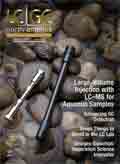A New Look at Sample Prep
LCGC North America
Sample preparation, I think it is safe to say, is not a favorite activity of most analytical chemists, and generally is regarded as a necessary evil. It tends to be time-consuming and tedious. Furthermore, methods developed for one set of analytes often don’t work for others, so you have to come back to it again and again, much as you might prefer to dedicate as little time and effort to it as possible, so that you get to the exciting part of the analysis - the actual separation and detection!
Of course, even those who dislike sample preparation know that doing it properly is essential to getting good analytical results. Yes, today there are more methods being developed for direct sample analysis without multistep sample preparation, but those are the exception, not the rule, and often most suitable for doing a quick assessment of a sample rather than for getting detailed information.
The good news is that there are analytical chemists who are willing to dedicate significant energy and focus to improving sample preparation approaches, and to explaining them to others, so that they don’t have to invest the time on their own. LCGC columnist Ron Majors is one of those people. Almost 25 years ago, he expanded the scope of his writing to go beyond the topics of his “Column Watch” column to include sample preparation, and the “Sample Prep Perspectives” column was born. Since then, he has been dedicating several column installments per year to this topic.
As many of you already know, however, Ron is slowly transitioning to retirement, and that includes gradually reducing his activities as a beloved LCGC columnist. The first step in this process is his handing over responsibility for the “Sample Prep Perspectives” column to Doug Raynie of South Dakota State University, starting with this issue.
We are, of course, very sad to see Ron make less frequent appearances in the pages of LCGC (though he will continue at the helm of “Column Watch” through the end of 2015). The good news is that we have an excellent successor to him in Doug Raynie, who received his PhD from Brigham Young University under the direction of Milton Lee. Sample preparation is a major focus of Doug’s work, and he has presented numerous workshops on sample preparation at conferences such as Pittcon and the Eastern Analytical Symposium. And it was Ron himself who invited Doug to take on the role.
“I recommended Doug to be my successor for the ‘Sample Prep Perspectives’ column because of his demonstrated interest in research and development work in sample prep technologies, including his long tenure with Procter & Gamble and most recently with his research work at South Dakota State University,” Ron said. “In addition, Doug has been a strong advocate of ‘green analytical chemistry,’ particularly in the use of supercritical fluids in chromatography and sample prep.”
Over the years, Ron added, he and Doug have coauthored articles on sample preparation in LCGC where Doug clearly demonstrated his writing abilities. You can see those skills in action in this issue, and in three guest installments of the column from 2014 (in the February, May, and December issues).
We are excited to welcome Doug Raynie to the team of venerated columnists of LCGC, as well as to the Editorial Advisory Board. We are confident that you will find his columns insightful and full of the practical advice that you expect to find in our pages, all designed to make your analyses more effective and easier.

Fundamentals of Benchtop GC–MS Data Analysis and Terminology
April 5th 2025In this installment, we will review the fundamental terminology and data analysis principles in benchtop GC–MS. We will compare the three modes of analysis—full scan, extracted ion chromatograms, and selected ion monitoring—and see how each is used for quantitative and quantitative analysis.
Characterizing Plant Polysaccharides Using Size-Exclusion Chromatography
April 4th 2025With green chemistry becoming more standardized, Leena Pitkänen of Aalto University analyzed how useful size-exclusion chromatography (SEC) and asymmetric flow field-flow fractionation (AF4) could be in characterizing plant polysaccharides.
This information is supplementary to the article “Accelerating Monoclonal Antibody Quality Control: The Role of LC–MS in Upstream Bioprocessing”, which was published in the May 2025 issue of Current Trends in Mass Spectrometry.












